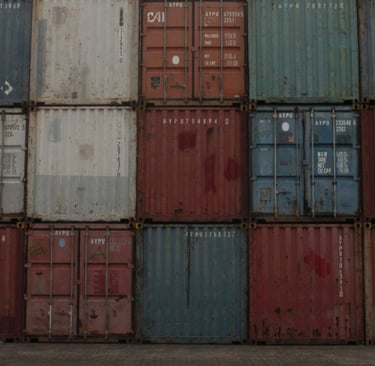From Waste to Resilience: How Tire Pyrolysis Strengthens Supply Chains
THE STORIES
TYROIL
7/3/20255 min read


In our increasingly interconnected world, the smooth flow of goods and resources underpins global prosperity. Yet, this intricate web of supply chains is surprisingly fragile, often vulnerable to disruptions caused by geopolitical conflicts, natural disasters, or economic shocks. Recent events, including the conflict between Iran and Israel, have starkly highlighted how quickly these vital arteries can be severed, leading to shortages, price hikes, and economic instability. But what if we could build resilience into these systems, transforming waste into a strategic asset that fortifies our supply chains? This is the powerful promise of tire pyrolysis, a technology that turns discarded tires into valuable resources, creating localized production loops that act as a buffer against global disruptions.
The Interconnected World: A Fragile Web
Modern supply chains are marvels of efficiency, designed to move goods and components across continents with precision and speed. However, their very interconnectedness can be their Achilles' heel. Many critical resources, particularly energy, are sourced from specific regions and transported through complex, often vulnerable, global networks. When geopolitical tensions escalate, these long and intricate supply chains become susceptible to a range of disruptions:
Route Disruptions: Conflicts can close or endanger key shipping lanes, straits, or pipelines, forcing rerouting that adds significant time and cost [1].
Production Interruptions: Direct conflict or political instability in resource-rich regions can halt or reduce production, creating immediate shortages in global markets.
Export Restrictions and Sanctions: Nations involved in or affected by conflicts may impose export restrictions or face sanctions, further limiting the availability of critical goods.
Price Volatility: Uncertainty drives up prices for commodities, especially energy, which then cascades through the entire supply chain, increasing costs for manufacturing, transportation, and ultimately, consumers [2].
The current geopolitical climate, with its inherent uncertainties, underscores the urgent need for strategies that can build resilience into these vital systems, moving away from a sole reliance on distant and potentially unstable sources.
Local Production, Global Impact: Shortening the Supply Chain
This is where tire pyrolysis offers a transformative solution. By converting locally generated waste tires into valuable resources like Tire Pyrolysis Oil (TPO) and recovered carbon black (rCB), it enables a shift from global dependency to local self-sufficiency. This localized production model inherently shortens supply chains, making them less susceptible to international disruptions:
Domestic Feedstock: The raw material – end-of-life tires – is available in virtually every country, eliminating the need for international sourcing of this particular input. This insulates the production process from geopolitical risks associated with foreign suppliers [3].
Proximity to Consumption: Pyrolysis plants can be strategically located near urban centers where waste tires are abundant and where the end products (TPO for local industries, rCB for local manufacturers) are consumed. This drastically reduces transportation distances and associated costs and risks [4].
Reduced Reliance on Imported Energy: By producing TPO domestically, nations and industries can lessen their reliance on imported fossil fuels, which are often subject to geopolitical whims. This diversification of energy sources strengthens national energy security and buffers against global energy shocks.
By fostering localized production, tire pyrolysis creates a more robust and predictable supply of essential materials and energy, reducing the vulnerability of industries and economies to external shocks.
Circular Economy as a Buffer: Building Regional Resilience
The concept of a circular economy is central to building supply chain resilience, and tire pyrolysis is a prime example of its application. Instead of a linear
model of 'take-make-dispose,' a circular economy aims to keep resources in use for as long as possible, extracting maximum value from them, and then recovering and regenerating products and materials at the end of their service life. Tire pyrolysis embodies this principle by transforming waste into valuable new resources, thereby strengthening regional economies and making them less vulnerable to international disruptions.
Resource Independence: By converting local waste into local resources, regions become less dependent on global markets for raw materials and energy. This fosters a sense of self-reliance and reduces exposure to the volatility of international commodity prices.
Economic Diversification: The establishment of tire pyrolysis facilities and the industries that utilize their products (e.g., rubber manufacturing, construction, energy generation) creates new economic sectors and job opportunities within a region. This diversification makes the local economy more resilient to downturns in specific global industries.
Waste as a Resource: Shifting the perception of waste from a burden to a valuable resource encourages innovation and investment in local processing capabilities. This not only solves a waste problem but also unlocks new economic potential.
This circular approach creates a powerful buffer against external shocks, ensuring that essential resources remain available and affordable, even when global supply chains are under stress.
A Logistics Company’s Story: Navigating the Storm
Consider:
TransGlobal Logistics, a fictional company heavily reliant on international shipping for its fuel and parts. When geopolitical tensions flared, their costs skyrocketed, and delivery times became unpredictable. Their CEO, Mr. Lee, faced mounting pressure from clients and shareholders. He realized their vulnerability lay in their dependence on distant, unstable supply lines.
Mr. Lee began exploring local alternatives. He discovered a new tire pyrolysis plant in a neighboring industrial park that was producing TPO. After successful trials, TransGlobal Logistics invested in converting a portion of their fleet to run on TPO. They also started sourcing some of their rubber components, previously imported, from local manufacturers who were incorporating rCB from the same plant. The transformation was remarkable. Their fuel costs stabilized, delivery times became more reliable, and they gained a significant competitive advantage. Mr. Lee proudly showcased their new, resilient supply chain, demonstrating how local innovation could buffer against global disruptions. For TransGlobal Logistics, tire pyrolysis wasn't just about sustainability; it was about survival and strategic advantage in a volatile world.
Conclusion: Tire Pyrolysis – A Key Strategy for Robust Supply Chains
In an era where geopolitical conflicts and global uncertainties are increasingly common, the resilience of supply chains is paramount. Tire pyrolysis offers a powerful and practical solution, transforming a persistent waste problem into a strategic asset for building robust, localized, and sustainable supply chains.
By fostering domestic resource production, reducing reliance on volatile international markets, and embodying the principles of the circular economy, tire pyrolysis acts as a vital buffer against disruptions. It empowers nations and industries to navigate turbulent times with greater stability, ensuring the continuous flow of essential resources and contributing to a more secure and prosperous future. Embracing tire pyrolysis is not just an environmental choice; it is a strategic imperative for building resilient economies in an interconnected and unpredictable world.
More Related Articles:
The Untapped Goldmine: A SWOT Analysis of Tire Pyrolysis Oil in the Global Market
The Diplomatic Fuel: How TPO Can Foster International Cooperation (Beyond Conflict)
The Investor's Lens: Why Tire Pyrolysis is Attracting ESG-Focused Capital
From Lab to Large Scale: The Journey of Pyrolysis Technology to Global Impact
References
[1] Geopolitical risk and oil volatility: A new insight. ScienceDirect. [https://www.sciencedirect.com/science/article/abs/pii/S0140988319303433]
[2] Impact of oil price volatility and economic policy uncertainty on inflation. ScienceDirect. [https://www.sciencedirect.com/science/article/pii/S2405844024025647]
[3] Energy Recovery from Waste Tires Using Pyrolysis. MDPI. [https://www.mdpi.com/1996-1073/13/7/1817]
[4] An economic analysis of scrap tire pyrolysis, potential and new opportunities. ScienceDirect. [https://www.sciencedirect.com/science/article/pii/S2405844022029577]
